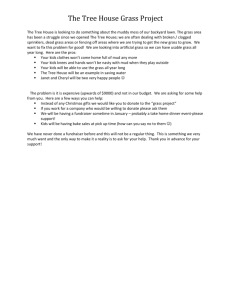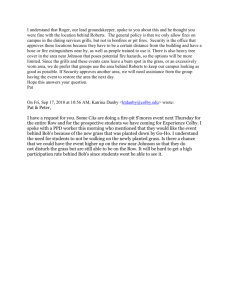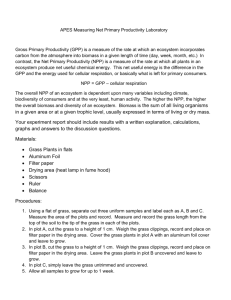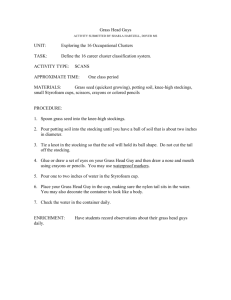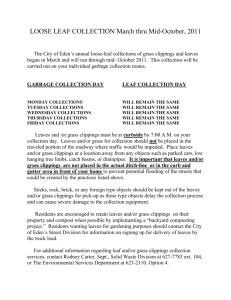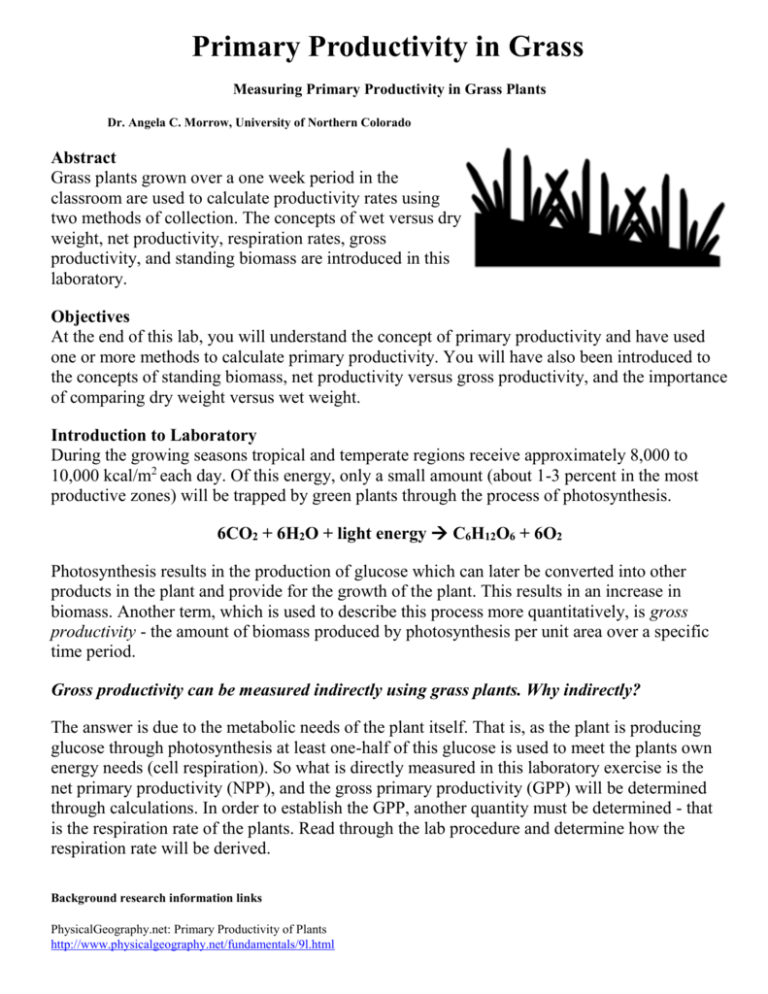
Primary Productivity in Grass
Measuring Primary Productivity in Grass Plants
Dr. Angela C. Morrow, University of Northern Colorado
Abstract
Grass plants grown over a one week period in the
classroom are used to calculate productivity rates using
two methods of collection. The concepts of wet versus dry
weight, net productivity, respiration rates, gross
productivity, and standing biomass are introduced in this
laboratory.
Objectives
At the end of this lab, you will understand the concept of primary productivity and have used
one or more methods to calculate primary productivity. You will have also been introduced to
the concepts of standing biomass, net productivity versus gross productivity, and the importance
of comparing dry weight versus wet weight.
Introduction to Laboratory
During the growing seasons tropical and temperate regions receive approximately 8,000 to
10,000 kcal/m2 each day. Of this energy, only a small amount (about 1-3 percent in the most
productive zones) will be trapped by green plants through the process of photosynthesis.
6CO2 + 6H2O + light energy C6H12O6 + 6O2
Photosynthesis results in the production of glucose which can later be converted into other
products in the plant and provide for the growth of the plant. This results in an increase in
biomass. Another term, which is used to describe this process more quantitatively, is gross
productivity - the amount of biomass produced by photosynthesis per unit area over a specific
time period.
Gross productivity can be measured indirectly using grass plants. Why indirectly?
The answer is due to the metabolic needs of the plant itself. That is, as the plant is producing
glucose through photosynthesis at least one-half of this glucose is used to meet the plants own
energy needs (cell respiration). So what is directly measured in this laboratory exercise is the
net primary productivity (NPP), and the gross primary productivity (GPP) will be determined
through calculations. In order to establish the GPP, another quantity must be determined - that
is the respiration rate of the plants. Read through the lab procedure and determine how the
respiration rate will be derived.
Background research information links
PhysicalGeography.net: Primary Productivity of Plants
http://www.physicalgeography.net/fundamentals/9l.html
Materials
6 plots of sod (approximately 6 x 8 cm) for each laboratory group
Balances
Scissors
Newspaper
Light Sources
Water
Drying oven or blotting paper and plant press for drying of plant material
Aluminum foil
Procedure
Your assigned task is to calculate the primary productivity of one week of grass growth using
two methods: (A) complete plant removal and (B) clipping. Select five plots of sod and trim to
approximately equal masses and grass heights. Designate two plots for procedure A and two for
B, the final plot is for the initial measurement of biomass.
i. Select six plots of sod and trim to approximately equal masses and grass heights.
Designate two plots for procedure A and three for B, the final plot is for the initial
measurement of biomass.
ii. Remove the grass plants entirely from one plot. Dust as much of the soil as possible from
the plants. Weigh and record the plant mass content from this plot. Place the plant
material from plot on a piece of paper labeled with your group name and initial plot.
iii. Then place on newspaper, (wrapped in labeled paper), and allow to dry
A.
1. Using plots for A, measure the grass length from the top of the soil to the tip of the grass
plants, record this data. (If the grass is highly variable in length it can be trimmed at the
beginning of the experiment to a standard length.)
2. Weigh and record the plant mass content from each plot. Cover one plot with aluminum foil.
3. Allow them to continue to grow for another week.
4. Remove the grass plants from the uncovered plot. Weigh and record this weight. Place on
labeled paper then on newspaper to dry.
5. Remove the foil from the covered plot. Observe and record the description of the appearance
of the grass. Weigh and record this weight. Place on labeled paper and then on newspaper to
dry.
B.
1. Using plots for B, measure the grass length from the top of the soil to the tip of the grass. If
the grass height is highly variable it can be trimmed as in the previous experiment.
2. Cut the grass from two of the remaining plots of to a height of 1cm being careful to keep the
cuttings for weighing. Weigh, record, and place clippings on labeled paper and the on
newspaper as in part A. Cover one plot with foil, leave one uncovered and allow to grow.
3. Being careful to keep the cuttings for weighing, cut the grass from a second plot of each of
the columns to a height of 1 cm. These plots will be left uncovered to grow. Weigh, record, and
dry as in Part A.
4. The third plot will remain untrimmed and allowed to continue to grow.
4. Allow grass to grow for one week.
5. Measure the height of the uncut grass plot. Record and then trim to 1 cm. Weigh clippings
and record, and then place on labeled paper to dry.
6. Measure the height of the grass that was cut the previous week. Retrim to 1 cm. Weigh
clippings and record, and then place on labeled paper to dry.
7. Uncover the foil covered plots and record the description of appearance. Measure height of
grass. If the grass has grown, trim to 1 cm, weigh clippings, record and place on labeled paper
to dry.
8. After all grass trimmings are completely dry, reweigh and then complete calculations and
questions below.
Data and Observations
Record the conditions under which you grew your plants and write of description of your plants
at the beginning and ending of the experiment.
Your data should include beginning wet and dry weights and concluding wet and dry weights.
These will be needed to complete the required calculations.
Calculations:
A. Dry weight of Week Two Uncovered Grass
- Dry weight of Week One Grass
Net productivity
Dry weight of Week One Grass
- Dry weight of Week Two Covered Grass
Respiration
Net Productivity + respiration = gross productivity for one week
Repeat these calculations using wet weight
B. Dry weight of Week 2 grass clippings from Uncovered Grass
- Dry weight of Week 1 grass clippings
Net productivity
Dry weight of Week 2 grass clippings from Covered Grass
- Dry weight of Week 1 grass clippings
Respiration
Net productivity + respiration = gross productivity
Recalculate using the data from the originally untrimmed plot and compare your results to
the trimmed uncovered lot.
Analysis Questions__________________________________________________________
1. Why in Part A was one set of plots harvested and the weight of the grass taken at the
beginning of the experiment?
2. What do the plots with the foil covering represent?
3. How would variations in respiration rates change your results? Under what conditions would
you expect the plants’ respiration rates to increase? Decrease?
4. Compare the difference in appearance between the foil covered and the uncovered grass. If
there is a difference in appearance, explain the difference.
5. If there was growth in the covered plots in Part B, account for why that growth might have
taken place even though there was no sunlight reaching the plant.
6. In Part A entire grass plants were harvested in contrast to Part B where the grass was only
trimmed. Why might the data from A give you a more complete picture of productivity versus
the data in Part B?
7. What units should be used to express productivity?
8. In your calculations, was there a significant difference between the dry weight and the wet
weights? Which of the two calculations would provide you with a more correct rate for gross
productivity? Why?
9. If you were a field scientist and needed a quick answer, how could you minimize this
difference?
10. Standing biomass is the organic matter of the living organisms in an area. Due to the
movement of animals, this term is most often just associated with the plants of an area. The
terms net productivity and standing biomass are often mistakenly used interchangeably. Why
would these terms not be interchangeable?
_____________________________________________________________________
Using the data from your entire class, draw a graph (3 graphs total) showing the results of the
respiration rate, net, and gross primary productivity experiments.
Your completed analysis will consist of the following:
1. Calculations (show all work)
2. Completed questions
3. Graphs
4. Written explanation of the results illustrated by your graphs.
Additional Reading Sources
Oak Ridge National Laboratory (ORNL) Distributed Active Archive Center's (DAAC)
http://www-eosdis.ornl.gov/
Net Primary Productivity Estimation: Using Boreal Ecosystem Productivity Simulator and Remote Sensing Inputs.
http://ccrs.nrcan.gc.ca/optic/npp_e.php
Net Primary Productivity Database.
http://www-eosdis.ornl.gov/NPP/npp_home.html Copyright © College Entrance Examination Board. All rights reserved.
A
PLOT
INITIAL
MASS
w/soil
DRY MASS
OBSERVATIONS
wo/soil
CONTROL
COVERED
UNCOVERED
B
PLOT
INITIAL
MASS
Of
clippings
UNTRIMMED
COVERED
UNCOVERED
X
DRY
DRY
OBSERVATIONS
MASS
MASS
WEEK 1 WEEK 2
X




